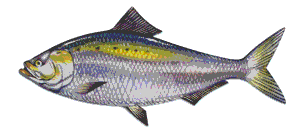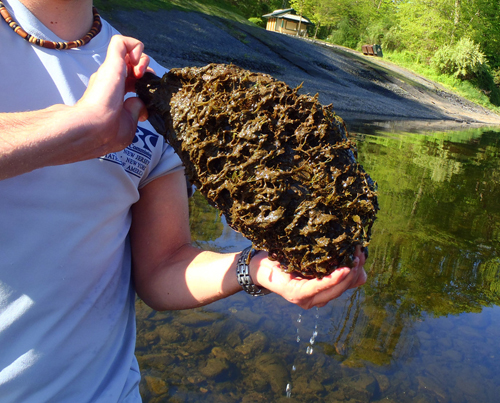Delaware • New Jersey • Pennsylvania
New York • United States of America
|
Living Resource Indicator |
Status |
Present Condition |
Trend |
|
Benthic Macroinvertebrates |
Mixed |
Conditions & trends vary by location; No clear trend in Delaware River |
↔ |
|
Fresh Water Mussels |
Poor |
Very poor in streams, better in main stem Delaware River |
↓ |
|
Eastern Oyster |
Fair |
Sustained with active management |
↔ |
|
Horseshoe Crabs |
Fair |
Improving with management. Egg densities affect shorebirds |
↑ |
|
Striped Bass |
Good |
Water quality improvements helped restore numbers; currently good adult stock numbers |
Variable |
|
Weakfish |
Fair |
Delaware's state fish is experiencing high natural mortality |
↔ |
|
Atlantic Sturgeon |
Poor |
Endangered; sitings are uncommon |
↓ |
|
American Shad |
Fair |
Some improvement; still low compared to historic numbers |
↔ |
|
American Eel |
Fair |
Moderate numbers currently |
Cyclical |
|
↑ Improving ↓ Worsening ↔ No Trend or Stable |
|||
The Delaware River Basin is blessed with a wide variety of native plants and animals that depend on the condition of our streams, rivers, wetlands, and forests. We are only reporting on a few that live in water. Many species are doing well, but some are feeling the effects of water quality problems, less space to live in, competition from non-native species, or combinations of factors that make it tough to survive and impossible to be healthy.
♦ Learn more about individual species (pdf 11 MB; TREB Ch. 6)
Scientists check on the health of streams and rivers in many ways. One test is to check the bottom of streams to see how many and what kind of insects are living there (benthic macroinvertebrate scores). You may not have heard about them, but just ask a trout fisherman about mayflies!
Many of these critters are very sensitive to changes in water quality and we use them as an early warning that there could be a problem. In addition to water quality, floods and droughts can also affect their condition. Measuring these little guys is both easy and hard. Easy, because you can wade into a stream to collect and count them. Hard, because aquatic insects form groups specific to each of the many types of streams in the Delaware River Basin, and because each state has a unique way to evaluate them. Reports range from excellent to poor. Not surprisingly, conditions in streams in the less-developed portions of the basin (green) are better for these important critters than in the more-developed (red) areas shown on the landscape map.
♦ Learn how the Delaware River and the streams in your state measure up (pdf 11 MB; TREB Ch. 6, pgs. 38-50)
DRBC is focusing on streams in the upper basin to record current conditions as a baseline in advance of potential natural gas development. Conditions are being recorded for at least 5 sites in each of 28 target watersheds, and water quality conditions are also being checked at 150 sites.
♦ Learn more about the status of DRBC's monitoring efforts in advance of potential natural gas development (pdf 5 MB)
Freshwater mussels and oysters are a class of larger benthic macroinvertebrates called bivalves (two shells). Since they eat by filtering their food out of the water, they help to make the water cleaner, but may also collect pollutants. Freshwater mussels are very important for water quality in streams, but are vulnerable to droughts, floods, and harvesting for use as bait and for their shells. Freshwater mussels are the most imperiled of all plants and animals in North America.
♦ Learn more about the Eastern oyster (pdf 11 MB; TREB Ch. 6, pgs. 29-32)
♦ Learn more about freshwater mussels (pdf 11 MB; TREB Ch. 6, pgs. 51-53)
The silvery green American shad is a river herring that was important to Native Americans and European colonists and remains so to anglers and riverfront communities. The fish are celebrated in festivals held to celebrate their arrival each spring. Shad spend most of their life at sea, returning to lay eggs - spawn - in the river where they were born. Over 300 miles of the Delaware River are open for migrating shad. The Schuylkill and Lehigh rivers and many streams now have special fish passages to allow fish to swim upstream past the dams that had blocked their way. More dissolved oxygen in the Delaware River, plus these passages, have increased the number of shad successfully returning to spawn, although their numbers remain at low levels. Shad are also food for other fish, especially striped bass. When striped bass are abundant, shad numbers are reduced, and vice-versa.
♦ Learn more about American shad
♦ Learn more about fish passage (pdf 16 MB; TREB Ch. 5, pgs. 34-38)
♦ Author John McPhee tells of the shad's importance in American history in The Founding Fish.
Didymo, or "Rock Snot," (Didymosphenia geminata) is an invasive, single-celled type of algae that can form extensive mats in freshwater streams, rivers, and lakes. Its blooms have mostly been a problem in cold, nutrient-poor water - like trout streams - where it can cover the streambed, rock surfaces, and aquatic plants and decrease food supply for fish. But, to the surprise of many scientists, this species may be expanding its range into warmer environments and into higher-nutrient waters. In fact, it is now believed to occur in many spots - and in two different shapes - along the 200 miles of the non-tidal Delaware River. DRBC will be investigating the many forms and odd living conditions of this alien species during the summer of 2013.
Effective in April 2012, the Atlantic sturgeon was listed as Endangered, making it illegal to fish for, catch, or keep them commercially or recreationally. In the Delaware River before 1890, there were an estimated 180,000 adult females spawning, and now spawning adults in the river are believed to number fewer than 300.
♦ Learn more about the endangered Atlantic sturgeon
♦ Learn more about the Atlantic sturgeon recovery program
Copyright © Delaware River Basin Commission,
P.O. Box 7360, West Trenton, NJ 08628-0360
Phone (609)883-9500; Fax (609)883-9522
Thanks to NJ for hosting the DRBC website



